
Affiliate marketing is one of the most effective ways to make money through your website. However, the way everyone’s doing it isn’t necessarily the way you should be doing it. For example, maybe you’re not a blogger, or perhaps you want to be original. Alternatively, maybe you do have a blog but want to explore new ways to expand your reach.
Fortunately, there are many different ways to promote your affiliate products outside of your blog. One or more of these methods may be what you’ve been looking for to help you earn extra money from your efforts.
In this article, we’ll discuss what affiliate marketing is and why you may want to try different approaches to it. Then we’ll review 12 less common (but potentially effective) ways to take your affiliate marketing strategy to the next level. Let’s get started!
What Affiliate Marketing Is (And How It Works)
Affiliate marketing is a digital marketing model that enables companies to reach more people at a lower cost than traditional advertising. Sellers do this by compensating third-party publishers, or affiliates, for promoting their products or services.
If you have an active blog, a YouTube channel, or a social media page, this makes you a good candidate for becoming an affiliate marketer. As an affiliate, you get to promote the seller’s offerings on your preferred platforms. In essence, you’re giving the seller a wider audience.
Related: We Wrote the Book on Affiliate Marketing — Get Your Copy
When someone makes a purchase through your channel, you’ll normally earn a commission on that sale. Alternatively, the brand may pay you for bringing in leads or driving traffic.
The vendor will give you an affiliate link that contains an ID that is unique to you. That way, when someone purchases a product through this URL, the seller can attribute the sale to you and give you a commission.
This model carries little risk for sellers because they don’t have to pay anything until you make a sale for them. However, it could potentially be very profitable for you as a publisher. It may take you a while to gain traction, but you can start earning a passive income without much effort once you do.
Why You Might Want to Try Affiliate Marketing Outside of Your Blog
 Blogging is one of the most common ways to promote products as an affiliate. Starting a blog can be a very simple process, and you can produce a lot of content without spending any money.
Blogging is one of the most common ways to promote products as an affiliate. Starting a blog can be a very simple process, and you can produce a lot of content without spending any money.
However, you may find yourself in a situation that makes blogging less than optimal for you. For example, you may not enjoy writing, or you have other skills you’d like to focus on, such as video-making and photography.
Alternatively, you may have built a following on another medium, such as a social media platform. Therefore, you may want to monetize that page instead of building another one from scratch.
Related: 16 Ways to Start Monetizing Your Website
However, there may be another very good reason to promote products outside a blog. As a professional marketer, you may be looking to diversify your income. That way, if one source fails, you have another recourse.
Setting up multiple channels can also help you grow your audience. However, if you do decide to promote products on more than one channel, it’s important to remember that focus is key in business. You may get better returns from managing one to three mediums very well, rather than five or six haphazardly.
To be a good affiliate marketer, you’ll need to get to know your audience. You’ll have to consider what places your target users frequent and what messages they respond to. Those factors should drive the bulk of your medium choice.
How to Boost Your Affiliate Marketing Income (12 Clever Strategies)
Now that you know the importance of evaluating all the channels available to you, it’s time to look at some effective options. Here are 12 strategies to help you stand out from your competition and take your affiliate marketing to the next level.
1. Promote Your Products in Email Newsletters
Since it’s such a strong medium, email will likely never go away. You can think of a customer’s email inbox as a curated feed of mostly relevant information – and they’re in full control of it.
Typically, if a user sees no value in an email, they delete it. If they see no value in a string of emails from the same company, they unsubscribe. On the other hand, if they like the emails they subscribed to, they’ll be more likely to engage with their content.
A newsletter is a regular email you send to your subscribers. Newsletters help build customer loyalty over the long term. In each email (or issue), you can give your audience updates, news, or the latest tips and tricks related to your offerings.
The technical aspects of starting a newsletter aren’t hard to handle with the right software. For example, Mailchimp comes with a solid suite of tools for email marketing.
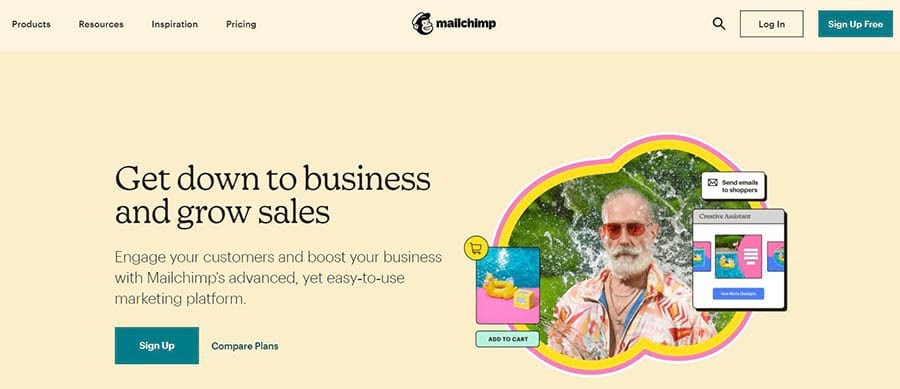 Building a loyal audience is the challenging part but also the most rewarding. The secret is knowing your audience and talking about what matters to them.
Building a loyal audience is the challenging part but also the most rewarding. The secret is knowing your audience and talking about what matters to them.
For example, if you share money-saving tips and strategies in your newsletters, you might recommend an accounting software that enables users to handle their finances. When readers click on an affiliate link in your newsletter, they’ll be taken straight to the product page on the vendor’s website.
Related: The Website Owner’s Guide to Email Marketing
2. Review Products in Videos
According to a December 2020 survey by Wyzowl, 84% of people report having been convinced to purchase a product or service after watching a video about it. The average amount of time people spend watching videos each week is 18 hours. What’s more, the pandemic has made 96% of viewers more likely to consume videos online.
Video is arguably the most personal medium. People get to see how you look and sound. This transparency can create an emotional connection. In turn, that connection can make viewers more likely to buy what you’re promoting.
YouTube is one of the most popular online video platforms. You’ll find many affiliate marketers on this channel. If you’ve ever heard someone talk about a product and tell you there’s a link in the description, there’s a good chance they’re an affiliate.
If you don’t mind being in front of a camera, you could give this strategy a try. For example, you could review your favorite products in engaging videos and place your affiliate links in the descriptions.
Gerald Undone reviews gear that people can use to create YouTube content in this useful review video.
 In the video description, you’ll see these two links:
In the video description, you’ll see these two links:
 As with all marketing materials, your video should include a clear Call to Action (CTA) that encourages viewers to take the next step. For example, you could ask them to click on the provided link to purchase the product.
As with all marketing materials, your video should include a clear Call to Action (CTA) that encourages viewers to take the next step. For example, you could ask them to click on the provided link to purchase the product.
Related: 7 Tips for Writing Winning Calls to Action for Your Website
3. Start a Podcast
The podcasting industry is growing in popularity. It is estimated to reach $95 billion globally by 2028.
As with video, podcasting allows you to tell a compelling story with your own voice. However, podcasts tend to be cheaper and easier to produce than videos. The main drawback is the missing the visual element, which may deter people who would rather watch a video.
Before you get started, you’ll need to reflect on the theme and format of your show. You’ll also need some gear – a good microphone and a pair of headphones at a minimum – and the right software. Fortunately, you can host your podcasts on WordPress. This platform integrates well with media hosting services such as Blubrry.
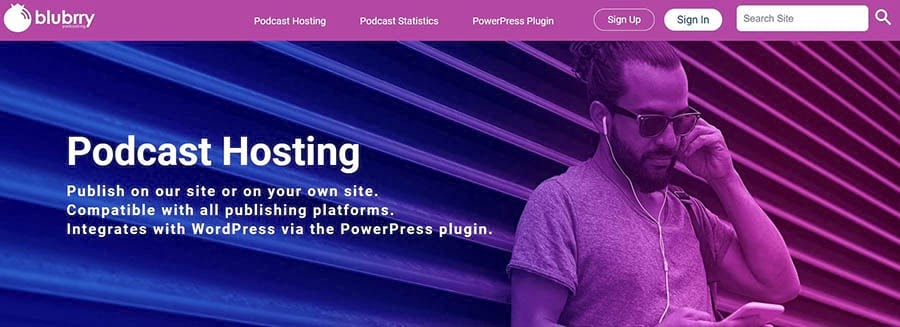 You can recommend a relevant product or service in each episode and provide an affiliate link in the captions. In addition, we recommend establishing a consistent schedule (e.g., one episode per week). This can help keep your audience engaged in your content, which may increase your revenue from affiliate marketing.
You can recommend a relevant product or service in each episode and provide an affiliate link in the captions. In addition, we recommend establishing a consistent schedule (e.g., one episode per week). This can help keep your audience engaged in your content, which may increase your revenue from affiliate marketing.
Related: Step-by-Step Guide: How to Start a Podcast With WordPress
4. Promote Products on Social Media Sites
In marketing, you go where your customers are. In the United States, 82% of the population is active on at least one social media profile.
You don’t even need to have your own website to promote products on social media. Instead, your profiles and business pages can act as your main platforms. The important thing is to choose the channel that represents the best union between the products you promote and the audience you’re targeting.
For instance, TikTok’s user base mainly consists of Generation Z. Therefore, this should be your chosen platform if you want to target the younger generation.
Meanwhile, if the products you want to promote are visually appealing, you may want to choose an image-heavy channel, such as Pinterest or Instagram.
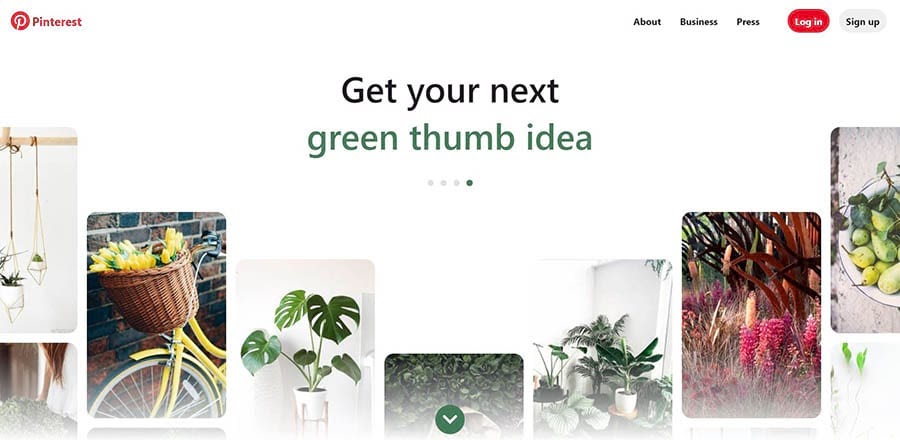 For instance, you can create graphics for Pinterest and include an affiliate link in the pin description. You could also post your stunning images on Instagram. However, keep in mind that you cannot embed links in Instagram posts. Many affiliates get around that issue by putting a link in their bio.
For instance, you can create graphics for Pinterest and include an affiliate link in the pin description. You could also post your stunning images on Instagram. However, keep in mind that you cannot embed links in Instagram posts. Many affiliates get around that issue by putting a link in their bio.
Related: Pinterest Marketing Guide: How to Promote Your Business
5. Write an Informative E-book
A well-written e-book with useful, actionable advice can position you as an expert in your field. A common approach is to make the e-book available for free, often in exchange for the user’s email address.
If you need some inspiration, you can go to Amazon Kindle and look at existing books in your industry. You may also want to check to see if they’re selling well. This will give you a hint as to the viability of your topic.
Related: How to Write a Blog Post — A Step-By-Step Guide
If there are too many books on your chosen topic, the competition may be strong. Therefore, you’ll need to see what you can do better than your competition to make your e-book more appealing.
When you’re writing your book, you’ll want to make sure to include your affiliate links in ways that are helpful to your readers. We also recommend using a soft-sell approach and only mentioning products where relevant. If you litter your book with links, you may come across as pushy and aggressive, which can put off your readers.
It may be a while before you see results from this strategy, but it’s important to keep working on it. For instance, you can promote your e-book on your website or social media pages.
6. Create an Online Course
Like podcasting, online learning is growing fast. A forecast by Research and Markets estimated that the market will grow to $350 billion by 2025.
The online learning platform Coursera saw its enrollment skyrocket by 664% in early 2020 compared to the same period in the previous year.
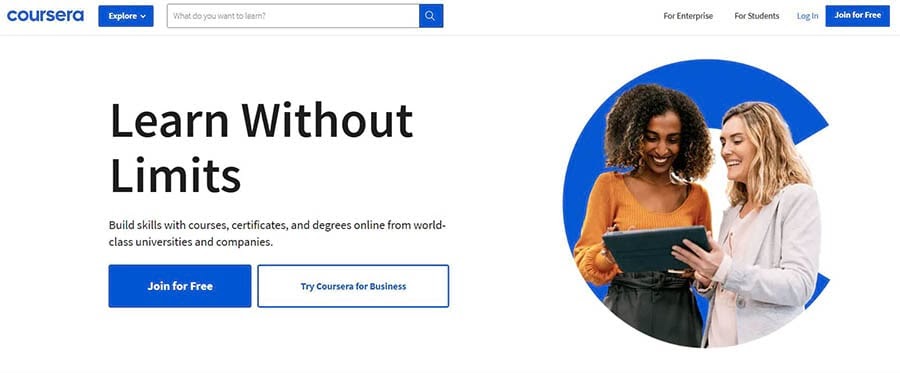 Meanwhile, Udemy saw a 425% surge during the same period. The demand for online courses remains higher than it did at pre-pandemic levels.
Meanwhile, Udemy saw a 425% surge during the same period. The demand for online courses remains higher than it did at pre-pandemic levels.
While pandemic-driven lockdowns and restrictions won’t last forever, the new worldwide attitudes toward online learning may. The changes in online education, formal or informal, appear to be permanent.
This presents a big opportunity for your business. It means that people worldwide are consuming something you can offer. While creating a high-quality online course requires a fair amount of work and time, once it’s ready, you can simply launch it on your site and start earning a passive income from it.
To profit from this trend, you’ll need to embed product promotions seamlessly within your course material. You can do this naturally by recommending products that enable students to do what you teach them.
However, nothing is stopping you from making your course about the product you want to promote. For instance, you could teach people how to use particular management software to run their online business more effectively.
A high-quality online course can help you build credibility. People may be more likely to listen to your recommendations if they trust you. This will, in turn, result in higher sales.
You could sell your course for a small fee or give it away for free. If your course is high quality, the second approach may lead to more signups.
Get Content Delivered Straight to Your Inbox
Subscribe to our blog and receive great content just like this delivered straight to your inbox.
7. Publish a Tutorial
Online tutorials are a popular way to learn new skills quickly. They often take the form of step-by-step articles or how-to videos. In particular, video tutorials differ from product review videos in that they are intended to teach the audience a specific skill.
Tutorials are a fantastic medium for affiliate promotion, whether in video or article form. You can teach your audience a skill that requires using a product you promote. For example, you could teach them how to do their taxes. Then, you would introduce them to the tax-accounting software you promote.
Alternatively, you can teach users how to use the very product you’re promoting. For example, you might show them how to use a customer relationship management (CRM) platform and encourage them to purchase it by providing an affiliate link.
To publish your tutorials, you have a few different options. For articles, you could use a platform such as Medium, where you can write and edit your articles directly while keeping track of audience statistics.
 For videos, YouTube is a great platform, as we discussed earlier. However, you could also publish your tutorial videos on your Facebook page or website.
For videos, YouTube is a great platform, as we discussed earlier. However, you could also publish your tutorial videos on your Facebook page or website.
8. Post in Online Communities and Forums
We tend to get together with those who share our interests and views. That’s the case with online communities. These are virtual places where people can exchange information on their common interests. They also enable users to support each other and share advice.
Social media communities exist as subcommunities of the larger social media landscape. Here is an example of a very active Facebook community, Science and Technology:
 You’ll also find plenty of online forums on the internet. These communities exist outside of social media as places to exchange useful information or advice. Reddit is one of the most well-known forum sites.
You’ll also find plenty of online forums on the internet. These communities exist outside of social media as places to exchange useful information or advice. Reddit is one of the most well-known forum sites.
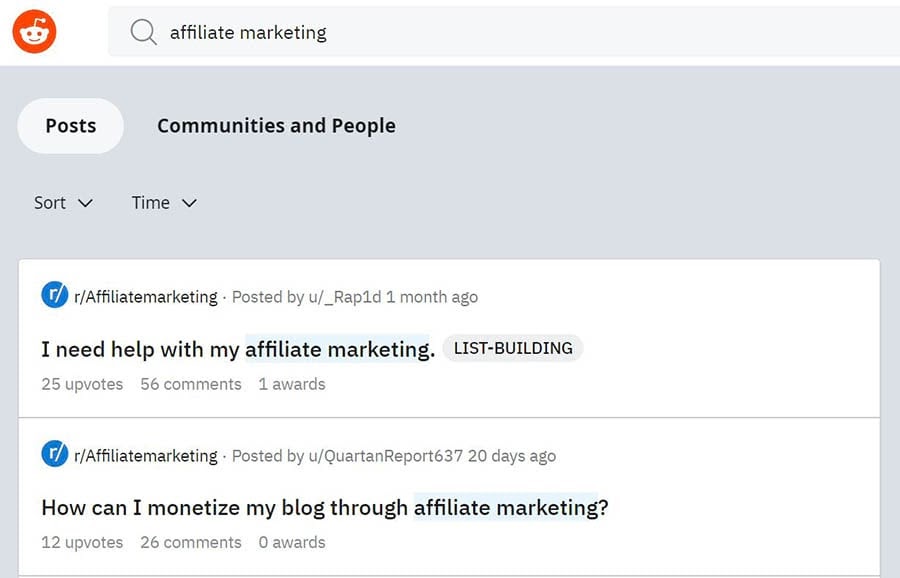 As a marketer, online communities are a boon for your business. You can communicate with people directly and answer any questions they may have. Often, you can keep your affiliate links as part of your profile so that users can visit them at any time.
As a marketer, online communities are a boon for your business. You can communicate with people directly and answer any questions they may have. Often, you can keep your affiliate links as part of your profile so that users can visit them at any time.
As you engage with online communities, you must abide by their community guidelines. Moreover, you’ll want to make sure you contribute valuable information consistently; otherwise, you may appear as though you’re only there for your own self-interest.
Related: 12 Ways to Stop Internet Trolls from Ruining Your Blog
9. Launch an Email Marketing Campaign
We’ve already discussed one common form of email marketing: newsletters. However, there are other options worth looking at, such as:
- Standard promotional campaigns: This is a one-time email to promote a specific product or service.
- Seasonal campaigns: Typically, these emails promote special offers around holidays.
- Triggered email series: This is a series of emails sent sequentially in response to an event, such as a product download, survey response, or new signup.
- Post-purchase drip emails: These are sent as a follow-up to a purchase to help build trust and loyalty with a new customer.
- Re-engagement campaigns: These are emails sent to subscribers who haven’t engaged with you for some time, with the hope to make them active again.
When done right, these email campaigns can be very effective for your affiliate marketing strategy. After all, email remains a powerful channel of communication. In a survey by MarketingSherpa, 86% of respondents said they like receiving promotional emails at least once a month. Fifteen percent of participants even said that they enjoy daily promotional emails.
The first step in setting up an email campaign is to sign up for a marketing tool. Mailchimp is a good option, as we discussed earlier. SendPulse is another powerful tool that gives you complete campaign automation with individual-level personalization.
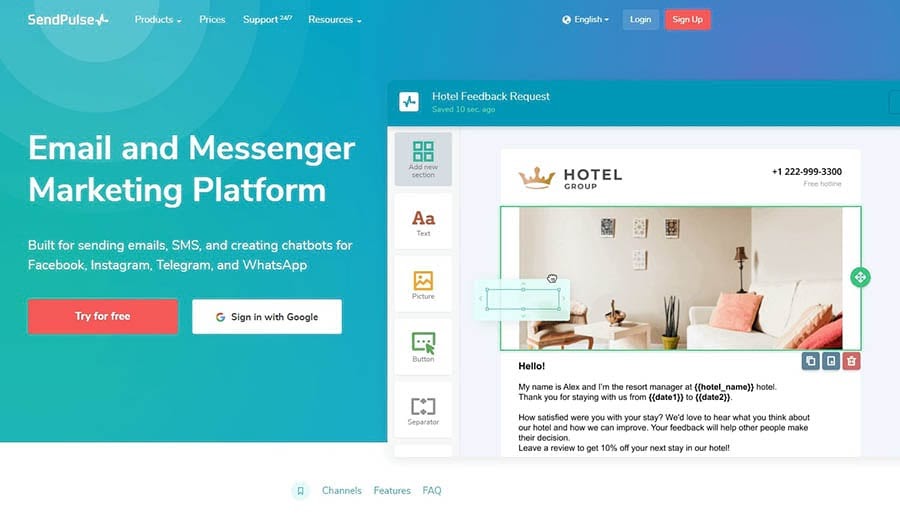 Next, you’ll want to produce amazing, share-worthy content and embed your affiliate links within it. You can also add social media buttons and an Email to a friend link to increase the recipient’s likelihood of sharing your content.
Next, you’ll want to produce amazing, share-worthy content and embed your affiliate links within it. You can also add social media buttons and an Email to a friend link to increase the recipient’s likelihood of sharing your content.
10. Purchase Online Ads
Purchasing online advertising may be the riskiest strategy in this post because you’ll have to put money on the line before you can see results. However, if you know what you’re doing, you may reach your target sooner than expected.
There are different kinds of ads for different mediums. Let’s talk about two kinds: Pay-Per-Click (PPC) ads and solo ads. Both methods are intended to take your prospects to your home page, a landing page, or another place designed to convert them. However, they work a little differently.
With PPC ads, you pay a small fee each time a user clicks on your ad to get to your target page. They are very common on the web. Here’s an example of what’s likely a PPC ad on Facebook:
 On the other hand, solo ads are more common among affiliates and information marketers. They are generally more expensive than PPC ads, but they are ideal for affiliate marketing purposes. Moreover, when these ads do work, they can be cheaper than other forms of advertising.
On the other hand, solo ads are more common among affiliates and information marketers. They are generally more expensive than PPC ads, but they are ideal for affiliate marketing purposes. Moreover, when these ads do work, they can be cheaper than other forms of advertising.
You can buy solo ads from someone who owns an email list that targets your ideal audience. Here’s how it works:
- First, you buy an ad from the list owner.
- Then, the owner sends out an email (the ad) to their subscribers about your products.
- Finally, subscribers click on the links and, hopefully, convert.
Whatever type of ad you choose, you’ll want to make sure to educate yourself first to avoid monetary losses. For instance, you may want to see some statistics and data about the email list, including click-through rates and demographics. This can help you choose the right affiliate product to promote to that particular audience.
11. Present Webinars
A webinar is an online presentation of educational content. It can be live or delivered as recorded video. There is often a good amount of audience interaction via instant messages or two-way video if it’s live.
Like courses and tutorials, webinars can boost your perceived trustworthiness and competence in the eyes of your audience. They are also a wonderful medium for presenting the solution to a problem in the form of the products you promote.
Webinars are relatively easy and inexpensive to deliver, though they require you to prepare some material and research your subject. However, your audience doesn’t normally expect you to follow a strict script. In that way, these webinars can seem more informal than a normal educational setting
After you’re finished with your initial delivery, you can reuse your recorded session. It can serve as another piece of marketing content to help promote your brand or drive more traffic to your website. For example, you can provide a link to your recorded webinar in your newsletters or post it on social media.
Webinars and email marketing reinforce one another. GoToWebinar reports that email marketing is responsible for more than half of webinar registrations. At the same time, requiring an email address when signing up for a webinar is an effective way to generate more leads.
To get started with your own webinar, you’ll first need to choose your topic and delivery format. Then, you’ll have to select the tools and platforms you want to use. Zoom, Livestorm, and ClickMeeting are all popular options:
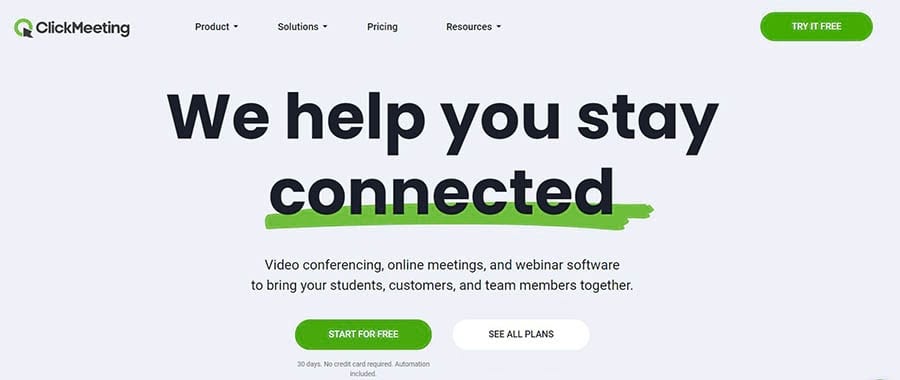 You’ll need to set a date and time and promote your webinar. However, before you put the word out, it’s important to have a registration page up and running. You’ll want to provide easy signup forms and give users the option to select their preferred webinar dates.
You’ll need to set a date and time and promote your webinar. However, before you put the word out, it’s important to have a registration page up and running. You’ll want to provide easy signup forms and give users the option to select their preferred webinar dates.
12. Join a Pay-Per-Call Affiliate Program
There is one other affiliate advertising model we haven’t covered: pay-per-call. This is somewhat different from every other method we’ve discussed so far.
In this model, the goal is for you to get people to call the company you’re promoting. You often have a unique phone number to share with prospects. That way, the company can attribute the call to you.
Pay-per-call advertising works particularly well for companies that sell or book appointments over the phone, such as locksmiths and tow truck services. The rationale is that making a phone call shows more of a purchasing commitment than simply looking at a website.
Consider joining a pay-per-call affiliate network if you think you can get people to make a phone call. You could also reach out to companies and ask them if they would be interested in collaborating with you.
Time to Get Creative
There are many effective ways to promote your affiliate marketing products that don’t require a blog. Whether you use them to complement your existing website or to forgo writing posts altogether, one or more of these methods could be your next hit.
In this post, we looked at some clever strategies for boosting your affiliate marketing income. For instance, you could promote products in newsletters, YouTube videos, or social media posts. You could also create high-quality courses and webinars and embed affiliate links in your educational material.
If you have a WordPress site and want to get started with affiliate marketing, you may want to consider looking at DreamPress. Our managed WordPress hosting plans handle updates and other maintenance tasks for you so you can focus on the important stuff: growing your business.
Power Your Blog with DreamHost
We’ll make sure your blog is fast, secure and always up so your visitors trust you. Plans start at $2.59/mo.

